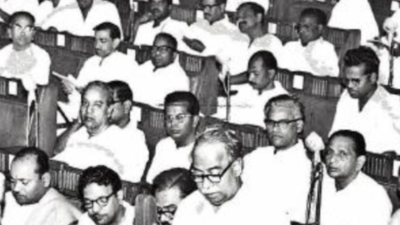Sangam verses, Chola ledgers: Tracing 2,000 years of Tamil Nadu budgets | Chennai News – The Times of India

New publication draws from palm-leaf manuscripts and copperplate inscriptions to give insights into how state balanced economic growth with social development
Centuries ahead of today’s global trade networks, Tamil merchants had a maritime network that extended from the port of Pukar to Rome, Southeast Asia and the Middle East. There are rare records from this period that show how customs duties such as Ulku and revenues from cotton and spice exports helped the region prosper, especially under the Cholas. With ship designs etched on their coins and tiger seals affixed to goods, Tamil seafarers left their mark in Thailand and Sri Lanka. The record of this practice, referenced in the ancient text Pattinapilai, reveals a system of financial governance that existed nearly 2,000 years ago.
Information palm-leaf manuscripts, copperplate inscriptions and libraries helped form the founda- tion of the publication ‘Tamils’ Financial Management: Antiquity and Continuity’, a heritage document published by the finance department of the Tamil Nadu govt. The book was presented during the Budget 2025-26. The publication delves into the history of the state’s fiscal practices from the Sangam era to contemporary budgetary reforms.
The Sangam era mentions sophisticated systems for generating and managing revenue. Land taxes and trade tariffs from subordinate regions were the main sources of state income, which was spent on building irrigation networks, supporting the arts and maintaining military strength.
Each of the Tamil dynasties had distinct yet sophisticated fiscal policies. The Cholas were known for their well-organised revenue system, where tax was collected through a zonal system. A chieftain would work with village heads and get the tax collected through them, and reinvest it into infrastructure such as irrigation systems, tanks, water systems, and temples.
Their financial administration too was well documented. The Thiruvalangadu copper plates of Rajendra Chola I read almost like an ancient audit report, providing details on revenue accounts and tax ledgers, even naming officials responsible for maintaining them. The system had built-in checks against abuse. Forced collection of taxes was a punishable offence and officials were fined, as evidenced by the Jambai inscriptions near Thirukovilur that records a fine imposed on a local official who drove a woman to suicide over tax collection.
The colonial period also introduced major changes to the way finances were managed in Tamil Nadu. Sir Thomas Munro, who implemented the ryotwari system had taxes collected directly from farmers, bypassing landlords and middlemen, an approach seen as more “equitable”, especially in a predominantly agrarian society.
It earned Munro the title “friend of the farmer”. When they were faced with a growing fiscal deficit in the Madras Presidency, British officials proposed revenue-generating measures, some of which resulted in opposition from within their ranks. James Wilson’s idea to introduce a licensing system for tobacco cultivation was opposed by Sir Charles Trevelyan, then governor of Madras, who also resisted increase in salt tax, stating that both moves were burdensome to the common people.
To address drought and famine in Ramanathapuram and Sivaganga districts, the idea of constructing the Periyar dam came about in 1799 to bring in surplus water from the western ghats to the area.
Similarly, the initial proposal for constructing a water storage structure across the Cauvery river was put forward by irrigation engineer Sir Arthur Cotton in 1834 but discussions on expenses led to construction delays. The frequent changes in the British administration and a famine slowed the project further. In 1864, Rs 54 lakh was given to construct the dam. Another famine delayed the project. Finally, construction began only in 1887 with a budget of Rs 87.5 lakh.
Post-independence, TN’s approach to financial governance entered a new phase, with the focus being on social development. The early 20th century saw the Justice Party lay the foundation for economic reforms that went beyond revenue collection and aimed to use state resources to uplift marginalised communities, with investments in education, healthcare and public infrastructure.
An early milestone in this direction was Muthulakshmi Ammaiyar’s advocacy for women and children. She used her first budget session speech in 1926 to push for a children’s hospital. TN’s revenue receipts crossed the ₹100 crore mark for the first time in 1961-62. Revenue receipts exceeded that figure the next year.
Successive govts have focused on industry, agriculture, welfare and urban development. From Kamarajar’s midday meal scheme and MGR’s nutritious meal scheme to Kalaignar’s Samathuvapuram and chief minister M K Stalin’s free travel for women, social welfare continues to drive the budget. The publication shows the importance of preserving and studying historic financial records to gain lessons on sustainable economic management, taxation policies and welfare programmes. It is a reminder that economic history is not just about numbers; it is about the socio-political decisions that shape the lives of millions.
(The writer is joint director of the Tamil Virtual Academy and compiled the publication)















